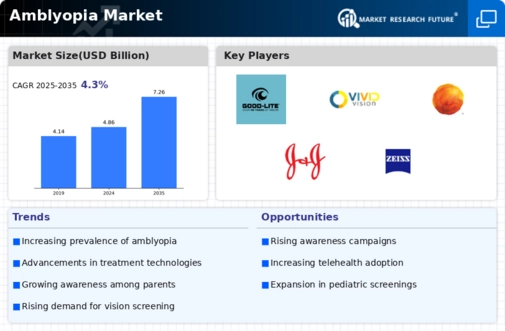Market Growth Projections
The Global Amblyopia Market Industry is poised for substantial growth, with projections indicating a market value of 4.86 USD Billion in 2024 and an anticipated increase to 7.26 USD Billion by 2035. This growth trajectory reflects a compound annual growth rate of 3.72% from 2025 to 2035. The factors contributing to this expansion include the increasing prevalence of amblyopia, advancements in treatment modalities, and heightened awareness among the public and healthcare providers. As the market evolves, it is likely to attract further investment and innovation, positioning itself as a critical segment within the broader healthcare landscape.
Rising Awareness and Education
The increasing awareness surrounding amblyopia and its long-term consequences is a crucial driver for the Global Amblyopia Market Industry. Educational campaigns targeting parents, teachers, and healthcare professionals are fostering a better understanding of the condition, leading to earlier diagnosis and treatment. This heightened awareness is likely to result in more children receiving timely interventions, thereby reducing the prevalence of severe visual impairment. As the market evolves, the demand for educational resources and screening tools is expected to rise, contributing to the overall market growth. The anticipated market value of 4.86 USD Billion in 2024 reflects this growing recognition of amblyopia's impact on quality of life.
Government Initiatives and Funding
Government initiatives aimed at improving eye health are significantly influencing the Global Amblyopia Market Industry. Various countries are implementing screening programs and public awareness campaigns to educate parents about the importance of early detection of amblyopia. For instance, national health organizations are allocating funds to support research and development of effective treatment strategies. This proactive approach is likely to enhance accessibility to care and foster a supportive environment for market growth. As a result, the market is projected to experience a compound annual growth rate of 3.72% from 2025 to 2035, driven by sustained government engagement in pediatric eye health.
Increasing Prevalence of Amblyopia
The rising incidence of amblyopia globally is a primary driver for the Global Amblyopia Market Industry. Current estimates suggest that amblyopia affects approximately 2 to 3 percent of the population, leading to a growing demand for effective treatment options. As awareness increases regarding the importance of early detection and intervention, healthcare systems are prioritizing amblyopia screening in children. This trend is expected to contribute significantly to the market, with projections indicating a market value of 4.86 USD Billion in 2024. The emphasis on pediatric eye health is likely to further propel market growth, as parents and healthcare providers seek to mitigate the long-term impacts of untreated amblyopia.
Advancements in Treatment Modalities
Innovations in treatment options for amblyopia are shaping the Global Amblyopia Market Industry. Traditional methods, such as patching and atropine drops, are being complemented by new technologies, including virtual reality and video game-based therapies. These advancements not only enhance patient engagement but also improve treatment adherence, which is crucial for effective outcomes. As these novel therapies gain traction, they are expected to attract investment and research funding, thereby expanding the market. The anticipated growth trajectory suggests a market value of 7.26 USD Billion by 2035, reflecting the increasing acceptance of diverse treatment modalities in managing amblyopia.
Technological Integration in Eye Care
The integration of technology in eye care practices is transforming the Global Amblyopia Market Industry. Telemedicine and digital health platforms are facilitating remote consultations and follow-ups, making it easier for patients to access care. Additionally, the use of artificial intelligence in diagnostic tools is enhancing the accuracy of amblyopia detection. These technological advancements are likely to improve patient outcomes and streamline treatment processes, thereby attracting more individuals to seek care. As the market adapts to these innovations, it is expected to grow steadily, with projections indicating a market value of 7.26 USD Billion by 2035.
















